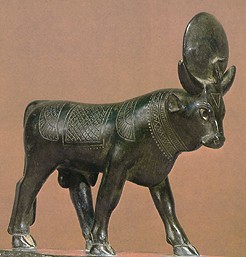
Ein heiliger Stier, der in Ägypten seit der Prädynastischen Zeit verehrt wurde. Verschiedene klassische Autoren liefern eine Menge von Informationen, die nicht alle verläßlich sind. Nur jeweils ein Apisstier wurde zur gleichen Zeit in Ägypten verehrt. Seine Auswahl wurde von der Existenz bestimmter körperlicher Merkmale abhängig gemacht, von denen es einigen klassischen Autoren zufolge insgesamt 29 gab, eine Zahl, die von den 29 Tagen des Mondzyklus beeinflußt war (der Apis stand in einem gewissen Verhältnis zu diesem Himmelskörper). Unter den wichtigsten körperlichen Merkmalen war ein weißes Dreieck auf der Stirn und schwarze Markierungen auf dem Körper, von denen eine, Herodot zufolge, wie ein Adler geformt sein mußte. Der Apis stammte aus Memphis und war mit dem Gott Ptah verbunden. Genauer gesagt, wurde der Apis als Ba des Ptah betrachtet. Vielleicht wegen der Verbindung Ptah-Sokar-Osiris war der Apis mit Osiris verbunden. Dieser Gott, der auch 'der große Stier des Westens' genannt wurde, gewährleistete, wie Apis, die Fruchtbarkeit. Die Pyramidentexte des Alten Reiches erwähnen bereits den Apis in Verbindung mit seiner Fruchtbarkeit, ein Motiv, das bei Diodorus Siculus wiederkehrt, der berichtet, daß Frauen vor dem Apis ihre Röcke zu heben pflegten. Die Beziehung Osiris-Apis war so eng, daß in der Griechisch-Römischen Zeit ein neuer Gott Sarapis (= Osir-Apis) geschaffen wurde. Der Apis hatte auch solare Züge, was durch die Sonnenscheibe, die seit dem Neuen Reich zwischen seinen Hörnern dargestellt wurde, und durch seine Beziehung zu dem Gott Atum verdeutlicht wird. Der Apisstier lebte, Herodot zufolge, im sogenannten Apieion nahe dem Tempel des Ptah in Memphis. Hier wurde er der Bevölkerung gezeigt und seine Bewegungen wurden als Orakel gedeutet. Der Stier wurde auch während Festprozessionen zur Schau gestellt. Dieser 'Apislauf' ist seit frühesten Zeiten bekannt. Der Zweck war, den Feldern Fruchtbarkeit zu verleihen. Im Rahmen seiner Rolle als Totengott, diente der Apislauf, wie an den Fußenden vieler Särge der Spätzeit dargestellt, dazu, den Toten zu seinem Grab zu tragen. Nach dem Tod des Apisstieres wurde er mumifiziert und im Serapeum begraben. Ein Teil des Mumifizierungsrituals für die Apisstiere ist in einem jetzt in Wien befindlichen demotischen Papyrus erhalten.